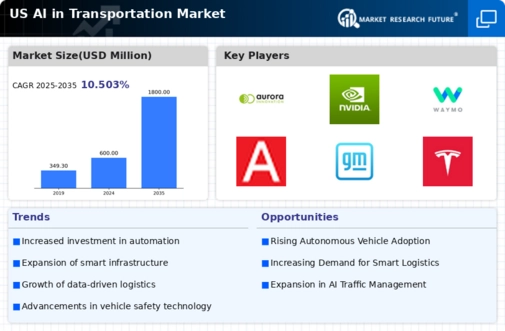The US AI in Transportation Market is experiencing rapid evolution driven by advancements in artificial intelligence and automation technologies, reshaping traditional approaches to logistics, public transportation, and automotive sectors.
Companies are constantly innovating to stay ahead, leveraging AI to enhance efficiency, safety, and user experiences. Competitive insights in this landscape reveal a dynamic environment where technology integration plays a vital role in determining the market leaders.
The push towards autonomous vehicles and smart infrastructure is attracting significant investment, emphasizing the importance of companies’ technological capabilities and partnerships to deliver advanced solutions that can scale across the transportation ecosystem.
Aurora Innovation has carved a noteworthy position within the US AI in Transportation Market by focusing on the development of self-driving technology. The company employs a distinctive blend of LiDAR, computer vision, and machine learning to create autonomous systems aimed at improving safety and efficiency in transportation.
Aurora Innovation’s strength lies in its innovative approach to collaboration, having formed alliances with various automotive manufacturers to accelerate the commercialization of its technology. This strategic positioning enables the company to rapidly integrate into existing infrastructures, catering to the burgeoning demand for autonomous solutions in urban and freight applications throughout the US.
The blend of solid technical expertise and a forward-thinking mindset positions Aurora Innovation favorably in a competitive marketplace where agility and partnerships are key.
NVIDIA, recognized for its prowess in graphics processing units, extends its influence in the US AI in Transportation Market through initiatives centered around AI computing and deep learning technologies for autonomous vehicles. Key products such as the NVIDIA Drive platform provide the necessary tools for developing advanced driver-assistance systems and fully autonomous vehicles.
The company’s strengths are amplified by its extensive partnerships with leading automotive manufacturers and tech firms, enabling a collaborative ecosystem that fosters innovation and quick adaptability in emerging trends.
NVIDIA’s active engagement in research, along with its strategic mergers and acquisitions, reinforces its market presence and bolsters its capabilities in AI-driven transportation solutions.
As a leader in computational power, NVIDIA continues to develop cutting-edge technologies that ease the adoption of AI in the transportation sector, facilitating a seamless transition towards smarter mobility solutions in the US.











